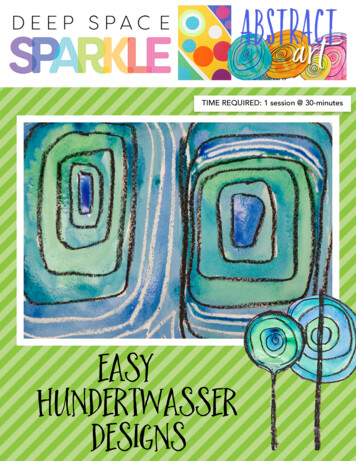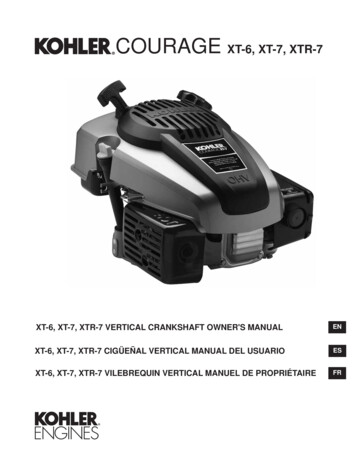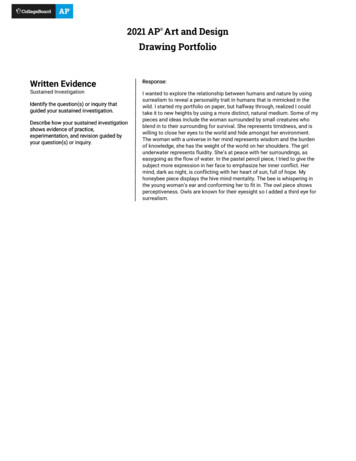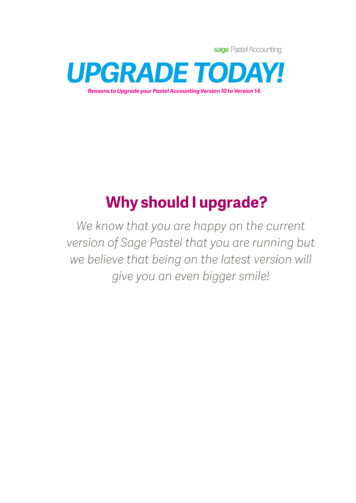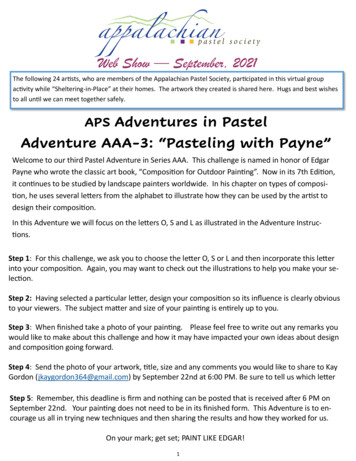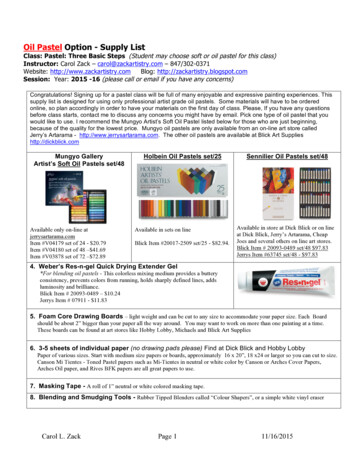
Transcription
Oil Pastel Option - Supply ListClass: Pastel: Three Basic Steps (Student may choose soft or oil pastel for this class)Instructor: Carol Zack – carol@zackartistry.com – 847/302-0371Website: http://www.zackartistry.comBlog: http://zackartistry.blogspot.comSession: Year: 2015 -16 (please call or email if you have any concerns)Congratulations! Signing up for a pastel class will be full of many enjoyable and expressive painting experiences. Thissupply list is designed for using only professional artist grade oil pastels. Some materials will have to be orderedonline, so plan accordingly in order to have your materials on the first day of class. Please, If you have any questionsbefore class starts, contact me to discuss any concerns you might have by email. Pick one type of oil pastel that youwould like to use. I recommend the Mungyo Artist’s Soft Oil Pastel listed below for those who are just beginning,because of the quality for the lowest price. Mungyo oil pastels are only available from an on-line art store calledJerry’s Artarama - http://www.jerrysartarama.com. The other oil pastels are available at Blick Art Supplieshttp://dickblick.comMungyo GalleryArtist’s Soft Oil Pastels set/48Available only on-line atjerrysartarama.comItem #V04179 set of 24 - 20.79Item #V04180 set of 48 – 41.69Item #V03878 set of 72 – 72.89Holbein Oil Pastels set/25Available in sets on lineBlick Item #20017-2509 set/25 - 82.94.Sennilier Oil Pastels set/48Available in store at Dick Blick or on lineat Dick Blick, Jerry’s Artarama, CheapJoes and several others on line art stores.Blick Item # 20093-0489 set/48 97.83Jerrys Item #63745 set/48 - 97.834. Weber’s Res-n-gel Quick Drying Extender Gel*For blending oil pastels - This colorless mixing medium provides a butteryconsistency, prevents colors from running, holds sharply defined lines, addsluminosity and brilliance.Blick Item # 20093-0489 – 10.24Jerrys Item # 07911 - 11.835. Foam Core Drawing Boards – light weight and can be cut to any size to accommodate your paper size. Each Boardshould be about 2” bigger than your paper all the way around. You may want to work on more than one painting at a time.These boards can be found at art stores like Hobby Lobby, Michaels and Blick Art Supplies6. 3-5 sheets of individual paper (no drawing pads please) Find at Dick Blick and Hobby LobbyPaper of various sizes. Start with medium size papers or boards, approximately 16 x 20”, 18 x24 or larger so you can cut to size.Canson Mi Tientes - Toned Pastel papers such as Mi-Tientes in neutral or white color by Canson or Arches Cover Papers,Arches Oil paper, and Rives BFK papers are all great papers to use.7. Masking Tape - A roll of 1” neutral or white colored masking tape.8. Blending and Smudging Tools - Rubber Tipped Blenders called “Colour Shapers”, or a simple white vinyl eraserCarol L. ZackPage 111/16/2015
9. Strong Paper towels – Bounty or Viva work well or blue paper towels from Ace Hardware.10. Scraping Tools – Single Edge Razor blades or any instrument you can use for scraping11. Plastic Banquet Table Cloth to protect table and working area in the classroom12. Wet Ones for Clean Up - two packages13. Your Photos 4”x 6” or 8” x 10” Photos for inspiration and reference (no published photos please)14. Surgical rubber gloves or finger cots to protect your manicure –(optional and not required)15. Glassine Paper to cover and protect your work between class room visits16. A Portfolio for carrying your work, foam board, and papers back and forth to class17. A Wheeled carrying cart or Satchel for other supplies to carry your other supplies to and from classCarol L. ZackPage 211/16/2015
Dry Soft Pastel Option - Supply ListClass: Soft Pastel – Three Basic StepsInstructor: Carol Zack – carol@zackartistry.com – 847/302-0371Website: http://www.zackartistry.comBlog: http://zackartistry.blogspot.comSession: Year: 2015 -16 (please call or email if you have any concerns)Welcome and Congratulations! Signing up for a pastel class will be full of many enjoyable and expressive paintingexperiences. Please review the list below to have your supplies on the first day of class. If you are just gettingstarted, this list will help you make the right selections and minimize the overall cost. I have selected the bestmaterials to give you the highest level of success. This is important because certain materials will give no success atall. Poor quality pastels will not allow you to make the many layers needed for creating a pastel painting. For thisclass you may purchase either soft pastels or oil pastels for this class. These pages are for soft pastel. If you wantto work in oil pastel ask for the oil pastel list instead. Either one will work for this class.Come to class prepared to work on the very first day. Please, If you have any questions before class starts, contactme to discuss any concerns you might have by email carol@zackartistry.com or by phone 847/302-0371.I will be happy to assist before you buy any materials.Safety Issues with Soft Pastel, First of all, soft pastels are very dusty and crumble easily. The professional artistquality sticks are very soft and are extremely rich and colorful. The sticks apply heavily to the paper and givewonderful coverage. You will need to prepare your working area to minimize the dust. Plan to work on an Easel(easels are provided in the room), Use a prepared “Trough’ to catch the dust (Instructor will provide), Do not blow thepastel to remove it from your painting in the class room AND FINALLY, Do not plan to use a spray fixative in theclass room. I will provide additional safety pointers for safe considerate painting in the classroom.lMixing Colors with Soft Pastel Unlike oil or acrylic paints, mixing colors is limited in pastel and done directly on thesurface/paper rather than on a pallet, so the more colors you have to work with the better. It is possible throughapplied layers to gently add an overlay of color on top of another color to change the overall color, i.e. white over redwill create pink or gently add the color orange over dark blue and it will change the bright dark blue to a dull darkblue.You will need a minimum of 15 - 20 colors of your choice, Warm - Reds. Oranges, Yellows, Cool - Greens, Blues,and purples, whites and blacks, so buy a good variety, and as many as you feel you can afford. There seems to bemany more colors in soft pastels than oil pastels to choose from. Boxed Sets are often good choices if you are justgetting started, because they usually have the color spectrum in the box. A small box of 12 is usually not enough.Pastel Brands and Places to purchase quality soft pastels Blick Art Supplies and several on-line stores are theplace to go for the good quality pastels you will need. Check the following list below locations, brands and prices:1. Sennelier Soft Pastels - An absolute must in any pastel artist’sstudio, Sennelier Soft Pastels have a world-wide reputation forexceptionally pigmented colors . . . and they have the largest andrichest collection of dark colors. Made from the purest pigmentschosen for their intensity and high lightfast rating, they arehandmade and air dried for four weeks to maintain a uniformsoftness.Preferred Soft Pastel Brand: Carol L. ZackPage 1Available in a wide range of setsand 525 open stock colors .Select Sennelier for the finestquality soft pastels available.2 Sizes: Standard and Half SticksSuper soft feel and textureMade from purest pigmentsFabulous deep dark tonesUsually available by the stick orthe boxed set.Set of 24 sticks are about 75.00(look for coupon or discountsbefore purchasing)11/16/2015
2. Unison Soft Pastels - Out of a frustration with the pastelsavailable, British artist John Hersey began making handmadepastels. Developed to be superior in color, texture and response,Unison Soft Pastels are unlike anything on the market today. JohnHersey worked out his unique color formulations over a decade ofexperimentation, creating intense, vibrant colors, blended almostexclusively from pure pigment and water. In his handmadeprocess, the pigment hardly gets pressed at all. The sticks arerolled lightly making them very fluent when you use them.Preferred Soft Pastel Brand: These pastels are truly a work ofart before you ever use them. Hand-rolled with no compressionor heating Made by hand to ensureconsistent creaminess andreliable softness Richly pigmented colors About 70.00 for a box of 36 Often available by the stick3. Where to find good quality soft pastelsThere are only a few places in the greater Chicago area who stock good professional quality pastels by the setand by the stick. I have listed phone numbers, websites and addresses to help you locate the right kind ofmaterials. Dick Blick (800) 447 – 8192 National,o (847) 619 – 1115 Schaumburg, IL.o (630)653-0569 79 Danada Square East, Wheaton, IL.o Dick Blick Website www.dickblick.comCheap Joes Website www.cheapjoes.comJerry’s Artarama www.jerrysartarama.comDakota Art Pastels www.dakotapastels.com 1-888-345-0067The Art Box, a new art supply store in Geneva, IL. 514 West State St. #101 Phone 630-232-2870http://artboxgeneva.com/4. Turpenoid, Alcohol or GamosolUsed to create an under-painting. You will only need a small bottleand an old stiff 1 or 2” brush, and a small plastic container Local Art Store or hardware store5. Drawing BoardYou will need to tape your Pastel Paper to a sturdy board.White or Black Foam core is light and ideal. Board should beabout 2” larger than your paper all the way around. If possiblepurchase more than one so you can work on more than onepainting. Can be purchased at HobbyLobby, Michaels and Blick. 2pieces are ideal so you can workon more than one painting at atime. Approx 24x306. Painting SurfacesAlmost as important as the pastels themselves are the varioussurfaces, papers or “grounds” on which soft pastels are applied.There are many kinds, permitting the pastellist a broad range ofvarious effects. Sanded papers are preferred. Buy large and cutwhat you need down to the size you think you want to work with Papers come in a wide range ofsizes from 19” x 25” to sheetsmeasuring up to 30” x 40”. Thebeginner must graduallyexperiment with many kinds ofpaper, but remember, pastelsticks are pretty chunky and thick,so it is not recommended to worktoo small in the beginning.Soft Pastels generally work best on a toned, textured or grittysurface so the pigment adheres or sticks to the surface. Pastel isseldom used on a white ground due to the fact that the colorsappear darker when laid on white, and seem to lack brilliance. Onthe other hand, a tinted or toned paper provides a background veryuseful in qualifying the color placed upon it. The preferred papertoday is a paper called Wallace that has a fine sandpaper (gritty)surface that many experienced pastel painters prefer.Carol L. ZackPage 2 Wallace - RecommendedSuede Mat Board & PastelMatPastelboardPastel PaperCharcoal Paper11/16/2015
7. Masking Tape – White or TanA roll of 1” wide neutral or white colored masking tape.8. Blending and Smudging ToolsSoft Pastel needs to be blended directly on the paper. Paperstomps (tortillons) usually work best for this medium9. Paper TowelsCanson Mi-Teintes Tonedpapers(Please Do not use Blue Masking Tapethe color of the tape will affect your colorjudgment) Paper Stomps or paper Tortillons Viva or Bounty work well10. Plastic Tablecloth & Cardboard Trough to catch dust at theEasel -You will need a piece of banquet table sized plastic tocover the table you use in the class room to minimize cleanup. If you are using soft pastel, another plastic sheet or table cloth forthe floor is also a good thing to have to protect the art classroomfloor from excessive dust and often the sheet or cloth will break thefall of a very expensive and much valued pastel stick and keep itfrom shattering. Large garbage BagPlastic Paint drop clothVinyl tablecloth for a picnic tableor banquet tableCotton/polyester sheet to use onthe floor to break the fall of pastelsticks should they accidentally fall.11. CleanupAt the end of each class period, the items listed in the rightcolumn work well to remove the pastel from your hands, easeland table. I prefer using Wet Ones. They are mild on my handsand help to remove the pastel from under your fingernails. Wet OnesSoap and WaterLots of Paper Towels!!! Bounty orViva seem to work the best!Nice to Have items:12. Your Photographs and digital camera. Bring your own photos printed from your camera, 4x6 or larger.Have your camera ready to take photos around the Fine Line and to photograph your work when youhave completed it. It is very important to make an archive record of all the work you do.13. Surgical Rubber Gloves and/or Finger Cots For those who have nice manicures, this is a nice to haveor use for Soft Pastel, if you are not allergic to the Latex.14. Glassine PaperLike Wax paper. Used to protect and store your pastel paintings and to keep the pastel from sticking orrubbing onto another surface before you frame it.15. Razor Blades - Great for scraping into the surface to create grasses or tree branches.16. Rice in a Plastic Tupper-wear container - Cleaning your pastels needs to be done occasionally. Oneway is to keep them in a plastic container with dry rice. The rice helps to remove the outer dust and helpsto capture the dust as well.17. A Portfolio - Great carrying case and storage for your paper and paintings. Larger than 18 x 24 is good.18. A Carry All - A carrying tote to hold all your supplies. Some of us are using carrying cases with wheelsto ease the transport to and from class. Home Goods and The Container Store are good resources.19.Easel - Nice to sit at a table and still have your work positioned up right as you work. The class roomhas easels that are adjustable for standing or sitting.20. Pastel Societies – The Pastel Society of America http://www.pastelsocietyofamerica.org21. The Pastel Journal Magazine - Barnes and Noble, also online at www.pasteljournal.comCarol L. ZackPage 311/16/2015
Oil Pastel Option - Supply List Class: Pastel: Three Basic Steps (Student may choose soft or oil pastel for this class) . 3-5 sheets of individual paper (no drawing pads please) Find at Dick Blick and Hobby Lobby Paper of various sizes. Start with medium size papers or boards, approximately 16 x 20", 18 x24 or larger so you can cut to size. .


